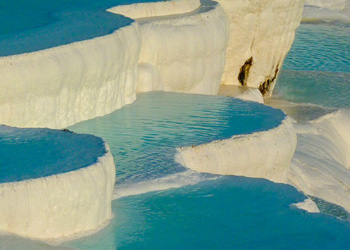


Pamukkale
Pamukkale
Pamukkale means ‘Cotton Castle’ in Turkish. That name comes from the world-famous white travertines of Pamukkale, which embellish the slopes of the UNESCO heritage site Hierapolis Ancient City. There are many hot springs in the area, and their temperatures range from 35 to 100 degrees Celsius. Most of the underground water sources are rich in minerals, and the calcium carbonate is carried to the surface deposits on the surface, creating spectacular white travertines. For centuries, the people of Anatolia considered the area as a healing center and built many baths during the Hellenistic and Roman times. Even though the earthquakes have destroyed those ancient structures, people come to Pamukkale area today and swim in the thermal pools inside the many resorts built in the area. Because of the excessive use of the waters of the travertines, Pamukkale faced blackening. Still, the Culture and Tourism Ministry banned the use of the calcium-rich waters in the hotels at the moment, so our next generations can see the same white beauty of Pamukkale. The ancient city of Hierapolis is the main attraction of the area along with its Roman Bath, Pool of Cleopatra, Temple of Apollo, Roman Theater, and the biggest Necropolis of Anatolia in the west of the ancient city. Denizli city near Pamukkale is the capital of textile production in Turkey, and agriculture is among the main income of the people living around Pamukkale today |
|
